#failovercluster
Explore tagged Tumblr posts
Video
youtube
Cluster Aware Updating | Failover Cluster Server 2019
0 notes
Text
Windows Server 2025 New Failover Clustering Features
Windows Server 2025 New Failover Clustering Features @vexpert #vmwarecommunities #windowsserversummit #windowsserver2025 #failovercluster #clustering #homelab #virtualization #hyperv #vhtforums #azurestackhci #clusterosrollingupgrade
As we have covered in our Windows Server 2025 series of new features, there are many great new improvements with Microsoft’s new server operating system. In this post, we will key in on the improvements specific to Windows Failover Clustering and Windows Server 2025 new failover clustering features. Table of contentsFailover Clustering is evolvingAzure Stack HCI feature parity and Cluster OS…
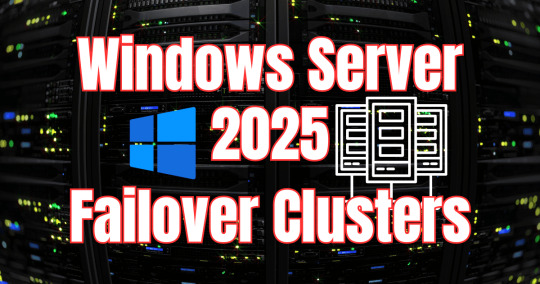
View On WordPress
0 notes
Text
How to perform storage migration in a Hyper-V failover cluster
Case
You have a Hyper-V cluster and you need to migrate virtual machine disk files and other disk-based clustered objects (such as paging files and snapshots) from an old storage repository to a new storage repository. This could mean migration between storage LUNs of the same storage system or between storage LUNs of different storage systems which are attached to the same hypervisor cluster. The migrated virtual machine disks may be of type .vhd, .vhdx, .vhdx shared or .vhds (VHD Set).
Solution
For best practice designs of Hyper-V clusters, you should review the following article: https://stefanos.cloud/kb/how-to-deploy-a-hyper-v-cluster-with-powershell/. Also you can purchase my e-book on Hyper-V cluster design best practices. https://stefanos.cloud/blog/windows-failover-clustering-design-handbook/ To migrate virtual machine storage, you should use the Hyper-V cluster storage migration feature. Via Failover Cluster Manager Follow the steps below in the Failover Cluster Manager console. - Open the Hyper-V cluster manager console and click on the VM whose storage you need to migrate between cluster disks (volumes). Right-click on the VM and choose command "Move --> Virtual Machine Storage".

On the upper section, choose either the entire source VM or some of the associated storage files which you wish to migrate (source). Then drag and drop the selected rows to the lower section into the target folder of the target cluster volume (target). After completing the drag and drop operation, you should see a summary of the before (source) and after (target) storage repository for the dragged storage entities, as shown in the example below.
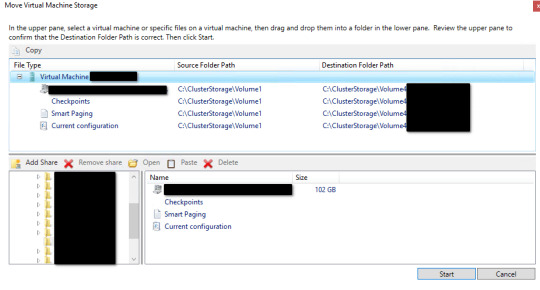
When you are ready click "Start" and observe the storage migration status in the Failover Cluster Manager console as well as by observing network traffic in the Windows File Explorer, from the source storage volume to the target volume. The storage migration initiation should be shown inside the Failover Cluster Manager, next to the VM record whose storage migration has started.

You should repeat the above steps for all virtual machines whose storage you wish to migrate. Via Powershell You can achieve the same Hyper-V virtual machine storage migration with the following example Powershell cmdlet. Move-VMStorage "SourceVM" -VirtualMachinePath D:MyVMsConfig -SnapshotFilePath D:MyVMsSnapshots -SmartPagingFilePath D:MyVMsSmartPaging -VHDs @(@{"SourceFilePath" = "C:MyVMsDisk1.VHDX"; "DestinationFilePath" = "D:MyVMsDisksDisk1.VHDX"}, @{"SourceFilePath" = "C:MyVMsDisk2.VHDX"; "DestinationFilePath" = "D:MyVMsDisksDisk2.VHDX"}) Storage migration of shared vhdx or vhds disks If you try to migrate a storage disk which is configured as a shared disk (either in .vhds VHD Set or .vhdx shared format) you will encounter the following blocking error and the storage migration will not be able to continue. Virtual hard disk C:ClusterStorage.vhdx cannot be moved because it is marked as shareable and shareable VHDs cannot be moved because the other VMs sharing this VHD would then have invalid configurations.
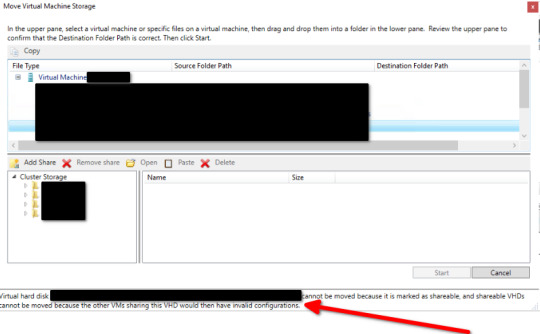
Shared disks are part of a guest WFC cluster If the shared disks to be migrated to another storage LUN are part of a Windows Failover Cluster (WFC) in a guest cluster fashion, for example in a SQL Server guest cluster configuration, then you need to carry out the following steps. - Shut down both guest cluster nodes (hosts). - Remove the shared VHDX/VHDS file from the second guest cluster node.
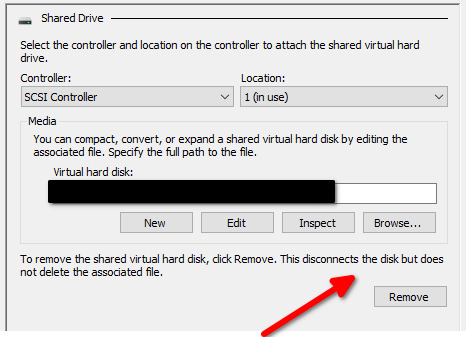
- Re-configure the VHDX/VHDS file to become a non-shared file. There is no official way to convert from VHDS to VHDX but only a workaround. Follow the steps below for this conversion from VHDS to VHDX.- Shutdown all the guest cluster VMs using the vhdx/vhds disk in question and detach the disk. - Copy/backup *.vhds and *.ahdx - Rename *.ahdx to *.vhdx - Use the Starwind V2V Converter too to convert to vhd or vhdx. - Re-attach the disk and verify functionality in your WFC cluster. - Power on the guest cluster node 1. - Perform the storage migration of the shared disks from guest cluster node 1. - Shut down node 1 again. - Re-configure the VHDX/VHDS file again to become a shared file and add it back to guest cluster node 2. - Power on both guest cluster nodes. Shared disks are not part of a guest WFC cluster In this case, you need to carry out the following steps. - Shut down the VM to which the shared disk in question is attached. - Remove the shared disk in question from the VM. This will detach the disk from the VM but it will not delete the actual disk file/data.
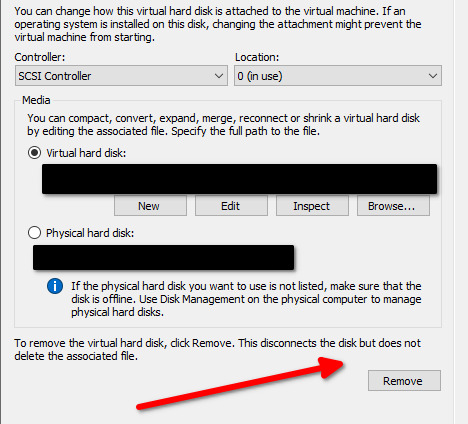
- Re-add the disk to the VM but this time choose the disk to be a non-shared disk.
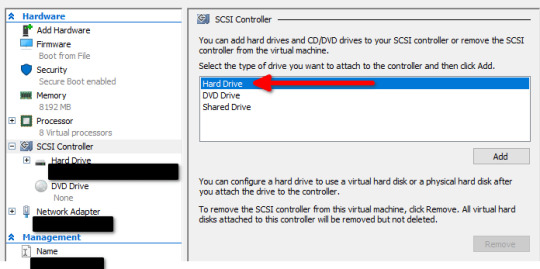
- Power on the VM and perform the storage migration from the WFC console.
Sources
https://docs.microsoft.com/en-us/powershell/module/hyper-v/move-vmstorage?view=windowsserver2022-ps https://social.technet.microsoft.com/Forums/Azure/en-US/27ccf285-e5c3-4819-8f9c-82784b8ba71a/convert-vhdset-to-vhdx?forum=winserverhyperv Read the full article
#failovercluster#hyper-v#livemigration#Microsoft#Powershell#Storage#storagemigration#vhdset#vhds#vhdx#virtualmachines
0 notes
Text
Windows Server 2019 Insider Preview Build 17733 released

Windows Server 2019 Insider Preview Build 17733 released. A Faster, Safer Internet with HTTP/2 and CUBIC The Internet is part of our daily lives at work and at home, and in the enterprise and in the cloud. Microsoft Edge on Windows 10 clients taking advantage of connection coalescing for HTTP/2, as supported by Windows Server 2019. Improved security in Microsoft Edge browsers due to guaranteeing HTTP/2 preferred cipher suites. Improved performance on Windows 10 due to Cubic, the new default TCP congestion provider. SDN Goes Mainstream If you’ve ever deployed Software Defined Networking (SDN), you know it provides great power but is historically difficult to deploy. Now, with Windows Server 2019, it’s easy to deploy and manage through a new deployment UI and Windows Admin Center extension that will enable anyone to harness the power of SDN. Cluster Sets (Hyperscale for Hyper-Converged) We have announced cluster sets previously, but since then, we have done additional work to improve placement of virtual machines. While preserving existing experience of Failover Cluster management experiences on member clusters, an instance of a cluster set additionally offers key use cases around lifecycle management of a cluster set at the aggregate. To recap, cluster sets is the new cloud scale-out technology in this preview release that increases, by orders of magnitude, the count of cluster nodes in a single Software-Defined Data Center (SDDC) cloud. A cluster set is a loosely-coupled grouping of multiple failover clusters: compute, storage, or hyper-converged. Cluster Sets technology enables fluidity of virtual machines across member clusters within a cluster set and a unified storage namespace across the set. Failover Cluster: Cluster Network Object The Cluster Network Object (CNO) in a failover cluster is crucial to the management of a cluster. When creating a cluster, the creation process will detect the IP address scheme that is used on the network cards. If your network uses DHCP, the Cluster IP address will automatically get an IP address from your DHCP server. If your network uses static IP addresses, you will be prompted to enter an IP address to be used. However, there are only so many IP addresses that may be available, so we have introduced new functionality that is available when creating a cluster and the CNO. You may be familiar with how a Scale-Out File Server (SOFS) works—an SOFS has a separate network name, and it is a distributed name. That means that the network name will take on the IP address of all the nodes. So, in DNS you can see the SOFS network name with an entry that is the IP address of the physical (or virtual) nodes. The system now offers that as an option for the CNO and will do some detection to make things a little easier, depending on how and where you create the cluster. There is now a new switch for FailoverClusters, PowerShell cmdlets for failover clusters, called –ManagementPointNetworkType that you can use with New-Cluster. The options for this switch are: Singleton: Use the traditional method of DHCP or static IP address. Distributed: Use a Distributed Network Name using node IP addresses. Automatic: Use detection. If running in Azure, use Distributed; if running on-premises, use Singleton (the default). So, for example, to create a cluster utilizing Node1 and Node2 on-premises, where DHCP provides IP addresses, and to have the CNO as a distributed name, the PowerShell command would be: New-Cluster -Name Cluster -ManagementPointNetworkType Distributed -Node Node1,Node2 If you use Failover Cluster Manager to create the cluster, it will default to using Automatic for the network type. This makes creating clusters in Azure a much easier process, because there is no need to create an additional Internal Load Balancer (ILB) for the Failover Cluster.
Available Content
Windows Server 2019 Preview is available in ISO format in 18 languages, and in VHDX format in English only. This build and all future pre-release builds will require use of activation keys during setup. The following keys allow for unlimited activations: Datacenter Edition 6XBNX-4JQGW-QX6QG-74P76-72V67 Standard Edition MFY9F-XBN2F-TYFMP-CCV49-RMYVH Windows Server vNext Semi-Annual Preview – The Server Core Edition is available in English only, in ISO or VHDX format. The images are pre-keyed – no need to enter a key during setup. Microsoft Hyper-V Server This build will expire December 14th, 2018. Known Issues The Virtual Hard Disk Miniport Driver (Vhdmp.sys) may experience a bug check, SYSTEM_THREAD_EXCEPTION_NOT_HANDLED (7e). A Remote Desktop connection may fail when Windows Defender Application Guard launches. This issue may affect preview releases starting with build 17727. When a Windows Defender Application Guard container crashes, the resulting type of dump may be unexpected. On a preview build of the operating system, Narrator is not available by default after installation. On an affected system, the audio service is disabled by default. A Multi-Resilient Volume (MRV) may fail to mount during node maintenance for a software-defined datacenter (SDDC) cluster, causing virtual machines to go offline. On recent preview builds, database applications might not be able to initialize a database and fail with a stack overflow or insufficient privileges when the database is located on an SMB volume. Shielded VMs running Linux do not boot. The loader (LSVMLoad) waits for a passphrase for the boot partition. Creating or modifying environment variables by using setx fails on a system running in a Nano Container (that is, Nano Server as a container image). On an affected system, setx requires a specific path in the registry, HKCU\Environment\, to exist by default. You can work around this issue by changing where the variable is stored in the registry, or you can add the expected registry path before executing setx commands. To specify that the variable be set for system-wide use in HKLM rather than in HKCU, the default, add the /M switch to a setx command. To instead add the expected registry path, run reg add HKCU\Environment before executing setx commands. Read the full article
0 notes
Text
Solution: How to build a high availability Postfix system? #development #programming #computers
Solution: How to build a high availability Postfix system? #development #programming #computers
How to build a high availability Postfix system?
I’m needing to set up a remote mirror for a postfix server (where the content of both mail servers should be the same at any time).
The idea is that if the main server comes down at some point the mirror server will take its place, manage the new incoming mails, and when the e-mail server comes up again, it will update it with the new e-mails and…
View On WordPress
0 notes
Text
Answer: How to build a high availability Postfix system? #fix #programming #answer
Answer: How to build a high availability Postfix system? #fix #programming #answer
How to build a high availability Postfix system?
I’m needing to set up a remote mirror for a postfix server (where the content of both mail servers should be the same at any time).
The idea is that if the main server comes down at some point the mirror server will take its place, manage the new incoming mails, and when the e-mail server comes up again, it will update it with the new e-mails and…
View On WordPress
0 notes
Text
Windows / Hyper-V 2008 R2 + Failover Cluster Manager hotfixes
Failover Cluster Manager
http://social.technet.microsoft.com/wiki/contents/articles/2008.list-of-cluster-hotfixes-for-windows-server-2008-r2.aspx
Hyper-V
http://social.technet.microsoft.com/wiki/contents/articles/3150.list-of-hyper-v-packages-updated-after-the-release-of-windows-server-2008-r2-service-pack-1-sp1.aspx
0 notes
Text
Unexpected errors when removing or adding node in SQL Server cluster
Case
After running SQL Server setup wizard to remove a node from a two-node SQL cluster, various cluster resources are removed and the SQL clustered instance remains in a failed state, even though the SQL Setup wizard had completed with exit code 0 (no errors). When trying to re-add the node, a series of errors occur, as described in this article. When trying to start the failed resources in the clustered SQL instance, the following error occurs (SQL error code 0x80071736):
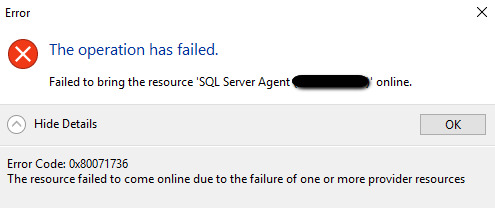
and/or the following error (SQL error code 0x8007139a), depending on whether the failed cluster resource has other failing dependency cluster resources or not.
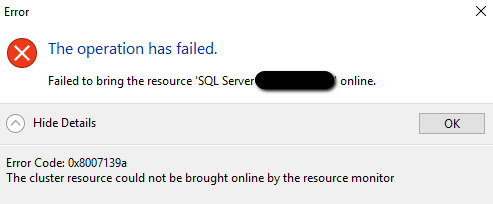
Also when trying to re-add the SQL node to the failed SQL instance, the client network access name is not shown (blank) and the following error occurs (SQL error code 0x84C00001):

Solution
Before you remove a node from the Windows Server operating system WFC cluster (evict node), it is important to first uninstall/remove any application-level clusters and other dependencies, for instance SQL Server clustered instances. In some cases however it appears that this can cause issues. In these cases, simply evicting the node from the WFC cluster is technically feasible and will not cause issues since the SQL clustered role basically relies on the WFC cluster information and keeps no separate configuration files, other than the registry. If the node which is being removed will be totally removed from the environment, then simply evicting the node can be justified. First investigate WFC cluster logs, SQL instance error logs, SQL server event logs and SQL Server setup logs. Check the cluster log on all cluster nodes, as per: https://blog.sqlauthority.com/2015/07/01/sql-server-steps-to-generate-windows-cluster-log/.

The SQL Server instance error log can be reviewed from inside the instance in SQL Server Management Studio. Each execution of Setup creates log files are created with a new timestamped log folder at %programfiles%Microsoft SQL Server100Setup BootstrapLog. The time-stamped log folder name format is YYYYMMDD_hhmmss. When Setup is run in an unattended mode, the logs are created at % temp%sqlsetup.log. All files in the logs folder are archived into the Log.cab file in their respective log folder. The SQL Server Setup logs should be investigated as per instructions at: https://docs.microsoft.com/en-us/previous-versions/sql/sql-server-2008-r2/ms143702(v=sql.105). Investigate all important cluster registry key groups: - Cluster - ComputerHKEY_LOCAL_MACHINECluster - Cluster Resources - ComputerHKEY_LOCAL_MACHINEClusterResources - Microsoft SQL Server - ComputerHKEY_LOCAL_MACHINESOFTWAREMicrosoftMicrosoft SQL Server I had same issue and checked again the cluster.log file, where I found following entries: r : Dependency expression for resource 'INSTANCENAME' is '()' 000022b0.00000958::2021/04/05-16:51:40.485 ERR SQL Server : Unable to open the SQL Server instance registry of 'Cluster' with error: 2. Please contact customer support 000022b0.00002fc0::2021/04/05-16:51:40.486 ERR SQL Server : GetRegKeyAccessMask: Could not get registry access mask for registry key SoftwareMicrosoftMicrosoft SQL ServerMSSQL15.INSTANCENAMECluster (status 2)). 000022b0.00002fc0::2021/04/05-16:51:40.486 ERR SQL Server : Worker Thread (1C8ECDE0): Failed to retrieve the SQL Server cluster registry key (last error = 2). 000022b0.00000958::2021/04/05-16:51:40.486 ERR SQL Server : SQL Cluster shared data upgrade failed with error 0 (worker retval = 2). Please contact customer support 000022b0.00000958::2021/04/05-16:51:40.486 ERR SQL Server : Failed to prepare environment for online. See previous message for detail. Please contact customer support 000022b0.00000958::2021/04/05-16:51:40.486 INFO SQL Server : SQL Server resource state is changed from 'ClusterResourceOnlinePending' to 'ClusterResourceFailed' 000022b0.00000958::2021/04/05-16:51:40.486 WARN Online for resource SQL Server (INSTANCENAME) failed. For some reason the SQL uninstall node setup had erroneously deleted some registry keys from path SoftwareMicrosoftMicrosoft SQL ServerMSSQL15.INSTANCENAMECluster. When i recreated them by using a healthy instance as reference, I was able to run the SQL Server repair wizard successfully. It appears that one good way to "reset" the registry key paths and values for a specific node of a WFC cluster is to evict the node from the WFC cluster and re-add it. This action needs to be performed with an administrator user which has all required permissions on the WFC cluster (file system, domain and registry) as well as permissions on the SQL cluster, if an SQL cluster is involved. You can try using the default domain admin user and then retest after refining the exact permissions needed. If there are still registry keys missing and you encounter akward behavior when running the SQL Server "Add node to existing cluster" wizard (i.e. SQL Server clustered instances not shown/populated by the SQL wizard), you should run ProcMon on the affected server at the time when the issue occurs and inspect which registry keys are being accessed. It is important to understand the registry path/key structure for all cluster related components in each WFC node. For this you should more sophisticated registry management tools, such as reg compare or the Nirsoft registry tool (for full registry snapshots or WinMerge for comparison of reg files). Run Powershell cmdlets to check available cluster resource types and cluster resource state: - Get-ClusterResource - Get-ClusterResourceType - Get-ClusterResourceGroup - Update-ClusterNetworkNameResource Check that all AD accounts (VNO, VCO) and permissions requirements have been met as per: https://docs.microsoft.com/en-us/previous-versions/windows/it-pro/windows-server-2008-R2-and-2008/cc731002(v=ws.10)?redirectedfrom=MSDN#BKMK_requirements. Also check that DNS forward and reverse resolution works consistently for all clustered instances from all WFC cluster nodes, as per: https://support.delphix.com/Delphix_Virtualization_Engine/MSSQL_Server/Resolving_Error_%22Failed_to_discover_cluster_address_for_cluster_environment%22_(KBA1594) Also check SPN status for all related computer objects and Windows services, as per: https://docs.microsoft.com/en-us/previous-versions/windows/it-pro/windows-server-2012-r2-and-2012/cc731241(v=ws.11). Check also that all WFC related network ports and protocols are allowed via the Windows Firewall in all WFC nodes, as per: https://docs.microsoft.com/en-us/troubleshoot/windows-server/networking/service-overview-and-network-port-requirements. Ensure also that the CLIUSR is present and enabled in all WFC nodes, as per https://docs.microsoft.com/en-gb/archive/blogs/askcore/so-what-exactly-is-the-cliusr-account. It is possible in some cases that a corruption occurs in the CLIUSR profile or more CLIUSR users are created and then deleted, which can lead to a corrupt configuration, as shown in the example below. If you encounter the below case, you will need to reboot the server in question and run Delfprof afterwards to cleanup the invalid user profiles.

Try a SQL Server node repair using SQL Server installation media (only on the passive node each time) as per the following article: https://www.mssqltips.com/sqlservertip/2592/fix-sql-server-agent-on-windows-failover-cluster/. When you repair an instance of SQL Server: - All missing or corrupt files are replaced. - All missing or corrupt registry keys are replaced. - All missing or invalid configuration values are set to default values. Before you continue, for SQL Server failover clusters, review the following important information: - Repair must be run on individual cluster nodes. - To repair a failover cluster node after a failed Prepare operation, use Remove node and then perform the Prepare step again. For more information, see Add or Remove Nodes in a SQL Server Failover Cluster (Setup). Possible and preferred cluster resource owners It is very important to check both the possible and preferred owner of each cluster resource at two levels: - Cluster role level Right click the SQL Server role, click Properties and check all relevant nodes in the General tab.

- Cluster role resource level (each role has many cluster resources underneath) Right click each of the cluster resources underneath the SQL role, click Properties and check all relevant nodes in the Advanced Policies tab.
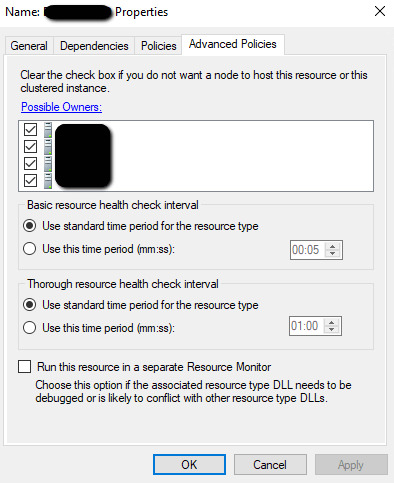
You need to ensure that the possible and preferred owners are consistent at both the cluster role level and the cluster role resource level for each subordinate resource. It appears that these settings can become inconsistent after removing a SQL Server node from the cluster by running the SQL Server wizard.
Sources
https://www.mssqltips.com/sqlservertip/2172/uninstalling-a-sql-server-clustered-instance/ https://www.mssqltips.com/sqlservertip/4231/how-to-remove-node-from-a-sql-server-failover-cluster/ https://docs.microsoft.com/en-us/previous-versions/sql/sql-server-2008-r2/ms191545(v=sql.105)?redirectedfrom=MSDN https://community.spiceworks.com/topic/1945302-sql-2014-add-node-fails https://serverfault.com/questions/1055297/cluster-network-name-blank-in-sql-cluster-node-configuration-setup-exit-with-e/1058129#1058129 https://support.delphix.com/Delphix_Virtualization_Engine/MSSQL_Server/Resolving_Error_%22Failed_to_discover_cluster_address_for_cluster_environment%22_(KBA1594) https://docs.microsoft.com/en-us/previous-versions/sql/sql-server-2008-r2/ms143702(v=sql.105) https://blog.sqlauthority.com/2016/04/13/sql-server-network-name-resource-fails-come-online-windows-server-2008-r2-failover-cluster/ https://joeydantoni.com/2012/06/29/recovering-from-a-deleted-cluster-resource/ https://docs.microsoft.com/en-us/troubleshoot/sql/failover-clusters/cluster-resource-goes-failed-state https://docs.microsoft.com/en-us/powershell/module/failoverclusters/update-clusternetworknameresource?view=windowsserver2019-ps https://docs.microsoft.com/en-us/troubleshoot/windows-server/networking/service-overview-and-network-port-requirements https://docs.microsoft.com/en-gb/archive/blogs/askcore/so-what-exactly-is-the-cliusr-account Read the full article
0 notes
Text
How-to: Why are my HyperV VM's randomly losing connectivity? #dev #programming #solution
How-to: Why are my HyperV VM's randomly losing connectivity? #dev #programming #solution
Why are my HyperV VM’s randomly losing connectivity?
I have a strange intermittent connectivity problem happening about once every two weeks.
First my configuration: I am running a HyperV failover cluster with two physical hosts (node01 and node02). The hosts are both running Windows Server 2008 R2 HyperV server (the free one) with SP1. On those hosts I am running two VM’s each running Windows…
View On WordPress
0 notes